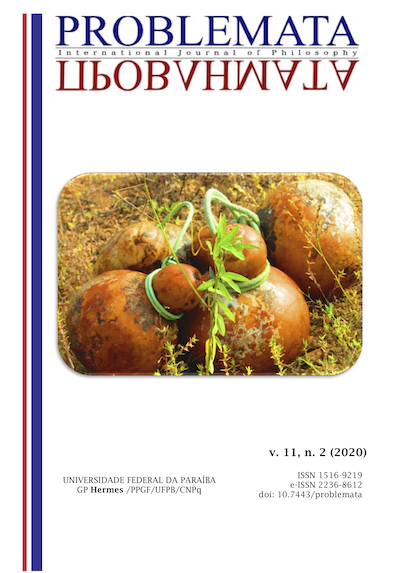DISMEMBERMENT AND HEALING IN THE BLUEST EYE
DOI:
https://doi.org/10.7443/problemata.v11i2.53731Keywords:
The Bluest Eye, Dismemberment, Identity, Trauma, HealingAbstract
This paper discusses the dismemberment of the black subject from the novel The Bluest Eye, by Toni Morrison. The hypothesis is that the events of everyday racism generate traumas. One of these traumas is the dismemberment of the identity of the black subject. For that, we will explore the Morrison's novel in order to identify in some episodes of racism the dismemberment of this identity and point out a possible cure through the act of narrating. Among the authors used, in addition to Toni Morrison, are: Sueli Carneiro and the epistemicide as a mechanism to lower the knowledge of the black subject; Grada Kilomba, who emphasizes racism as a traumatic event and the need to become subjects; bell hooks talks about the difficulty of black women in choosing intellectual life; Conceição Evaristo and the concept of escrevivência as a rescue of black protagonism and Carolina Maria de Jesus and her example as an intellectual. These authors demonstrate that racism produces suffering, but that healing can be accomplished through the act of narrating and not allowing history to be forgotten.
Downloads
References
ADISA, Opal Palmer. “Balançando sob a luz do sol: stress e mulher negra”. In: WERNECK, Jurema; MENDONÇA, Maísa; WHITE, Evelyn C. O livro da saúde das mulheres negras: nossos passos vêm de longe. Rio de Janeiro: Pallas / Criola, 2000, p. 111-115.
AKHTAR, Jaleel. Dismemberment in the Fiction of Toni Morrison. Cambridge Scholars Publishing, 2014.
ALMEIDA, Maria. Emília. Sousa. A força do legado transgeracional numa família. Psicologia: Teoria e Prática, São Paulo, v. 10, n. 2, p. 215-230, 2008.
ANZALDÚA, Gloria. Falando em línguas: uma carta para as mulheres escritoras do Terceiro Mundo. Revista Estudos Feministas, v. 8, n. 1, p. 229-236, 2000.
CALDIN, Clarice Fortkamp. A leitura como função terapêutica: Biblioterapia. Encontros Bibli: Revista Eletrônica de Biblioteconomia e Ciência da Informação, Florianópolis, n. 12, dez. 2001.
CARNEIRO, Aparecida Sueli. A construção do outro como não-ser como fundamento do ser. Tese (Doutorado em Filosofia da Educação). Programa de Pós-Graduação em Educação. São Paulo: Universidade de São Paulo, 2005.
FARIAS, Tom. Carolina: Uma biografia. Rio de Janeiro: Malê, 2017.
HAYES, Martina Louise. Legacy of Shame: A Psychoanalytic History of Trauma in The Bluest Eye. ETD Archive, 2015. Disponível em: <https://engagedscholarship.csuohio.edu/etdarchive/880>. Acesso em: 27 de maio de 2020.
HOOKS, bell. Intelectuais Negras. Revista Estudos Feministas, n. 2/95, v. 3, 1995.
JESUS, Carolina Maria de. Diário de Bitita. Rio de Janeiro: Nova Fronteira, 1986.
______. Quarto de despejo. Edição Popular. São Paulo: Francisco Alves, 1963.
KILOMBA, Grada. Memórias da Plantação: episódios de racismo cotidiano. Rio de Janeiro: Cobogó, 2019.
LAPLANCHE, Jean; PONTALIS, J.B. Vocabulário de psicanálise. São Paulo: M. Fontes, 1994.
MCDONNELL, Eric D. Jr. As If We Were Alive: Trauma Recovery in Toni Morrison's Beloved and The Bluest Eye. Honors Research Projects, 2016. Disponível em: http://ideaexchange.uakron.edu/honors_research_projects/355. Acesso em: 27 de maio de 2020.
MORRISON, Toni. The Bluest Eye. New York: Vintage International, 2007.
______. O olho mais azul. São Paulo: Companhia das Letras, 2019.
______. Romantizando a escravidão. In: MORRISON, Toni. A origem dos outros: seis ensaios sobre racismo e literatura. São Paulo: Companhia das Letras, 2019b.
SANTOS, Joel Rufino dos. Carolina Maria de Jesus: uma escritora improvável. Rio de Janeiro: Garamond, 2009.
SOUZA, Neusa Santos. Tornar-se Negro. Rio de Janeiro: Graal, 1983.
SPIVAK, Gayatri Chakravorty. Pode o subalterno falar? Belo Horizonte: Editora UFMG, 2010.
Downloads
Published
Issue
Section
License
Authors who publish with this journal agree to the following terms:
- Authors retain copyright and grant the journal right of first publication with the work simultaneously licensed under a Creative Commons Attribution License that allows others to share the work with an acknowledgement of the work's authorship and initial publication in this journal.
- Authors are able to enter into separate, additional contractual arrangements for the non-exclusive distribution of the journal's published version of the work (e.g., post it to an institutional repository or publish it in a book), with an acknowledgement of its initial publication in this journal.
-
- Authors are permitted and encouraged to post their work online (e.g., in institutional repositories or on their website) prior to and during the submission process, as it can lead to productive exchanges, as well as earlier and greater citation of published work (See The Effect of Open Access).





